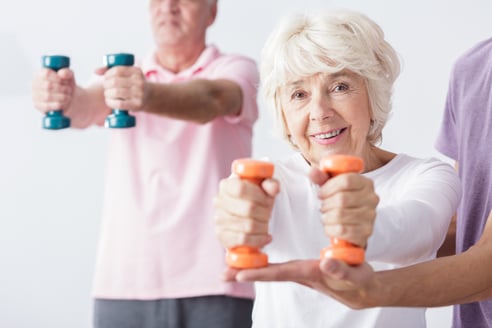 The benefits of regular activity for individuals throughout their lifespan is clear through the many (many, many) studies that outline how much movement is enough and which elements of health are improved with activity. However, despite the research, people in the U.S. still simply don't get enough activity to sustain health benefits, and the rate of inactivity in the older adult population is even more startling.
The benefits of regular activity for individuals throughout their lifespan is clear through the many (many, many) studies that outline how much movement is enough and which elements of health are improved with activity. However, despite the research, people in the U.S. still simply don't get enough activity to sustain health benefits, and the rate of inactivity in the older adult population is even more startling.
Sedentary behavior as we age can be linked to chronic diseases like arthritis and heart disease. Although these conditions are common in older adults—and in many cases, regular exercise can help individuals manage those health issues—seniors often feel limited by their chronic illnesses. If you're having trouble growing participation in your community exercise program, you might be missing this important audience. Improve your senior living exercise program and focus on chronic disease to address these health concerns.
- Arthritis: Exercise is one of the most crucial options for arthritis management. Regular activity helps lubricate the joints and can help reduce overall pain and stiffness that is often present among individuals with arthritis. Moreover, obesity is a risk factor for the disease, and increasing physical activity levels can help better manage the debilitating symptoms of arthritis.
[Related Content: Pick your arthritis battles: how exercise can help]
- Heart disease: Heart disease is one of the biggest causes of death in the United States. The Centers for Disease Control and Prevention state that about one in every four deaths is attributed to heart disease. More people exercising later in life can help reduce the number of individuals with heart disease through the management of blood pressure and blood glucose, and decreasing LDL cholesterol.
- Metabolic Dysfunction (type II diabetes and obesity): Type II diabetes and obesity are two closely related diseases in which the body is in metabolic dysfunction. Exercise can help maintain proper body weight and help regulate blood glucose and insulin levels to make the body more efficient.
- Cancer: Exercise has been shown to help lower overall cancer risk among a variety of different forms of cancer. Studies have shown a 30 to 40 percent reduction in breast cancer risk among women who perform moderate to regular exercise.
- Hypertension: Exercise can help lower systolic blood pressure significantly through moderate-intensity physical activity. Try breaking up exercise into three bouts throughout the day lasting for at least 10 minutes each to receive blood pressure–lowering effects.
- Depression: Exercise can have a beneficial effect on personal mood. Studies suggest that group exercise classes can help reduce symptoms of depression by 30 percent or more in exercising older adults. The modest improvement in depressive symptoms can help maintain an overall greater vitality later in life and help prevent negative feelings or thoughts that are common with aging.
- Dementia: Dementia is a disabling condition affecting many older adults. With a wide range of mental disorders categorized as dementia, there is a great need to understand how to prevent the condition. Exercise is one prevention strategy that can help slow the mental decline. One study showed a 37 percent reduced risk and a 66 percent reduction in risk of dementia when older adults performed moderate-intensity exercise, suggesting every adult ought to exercise to help lower the risk of mental decline and to help prevent mental disability later in life.
- Insomnia: Certain medications and life events can prevent the body from proper sleep. Higher levels of physical activity can help tire the body enough to place it in a position for restful and lasting sleep. Avoid strenuous exercise two hours before bed to obtain these benefits, and aim to meet the daily activity recommendations.
Need help ramping up community exercise programs to reach a broader audience? Find out more about NIFS consulting service where we bring our expertise to your community.


